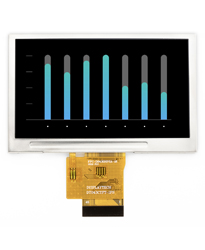Capacitive Touch Screen TFT LCDs
Multi-touch LCD Displays
Capacitive (PCAP) TFT LCD Displays
Take your product to the next level with a capacitive touch screen LCD by Displaytech. Our PCAP (projected capacitive) touch screen technology is a premium alternative to a resistive touchscreen. We offer capacitive touchscreens for our 2.8-inch, 3.5-inch, 4.3-inch, 5-inch and 7-inch TFT LCD displays.
About Capacitive Touch Screens
Capacitive touch is currently the most popular touch screen option for TFT LCDs on the market.
Capacitive touch technology allows for an enhanced product user interface since it supports gestures and proximity sensing. Unlike resistive touch screens which rely on pressure, capacitive touch responds to an electric current and can handle multi-finger touch points. This means that capacitive touchscreens can be used with your bare finger and it supports gestures such as pinch-to-zoom or swipe.
Capacitive touch displays are well suited for many products including:
- Wearables
- Smartwatches, sports and fitness products, home health devices
- Cameras
- Action cameras, dash cams and back up cameras
- Mobile devices
- Smart phones, GPS navigators, hand-held radios
- Home automation
- Thermostats, smart appliances, alarm and surveillance systems
Key Features and Benefits of Capacitive Touchscreen Technology
Capacitive touchscreen technology provides several significant advantages:
Multi-Touch Support
- These screens enable the use of multiple touch points simultaneously
- Capacitive touch displays respond to your finger(s) or stylus
Exceptional Touch Sensitivity and Precision
- Capacitive screens offer highly sensitive and accurate touch responses
- These displays can even detect input from a gentle, light touch
- Capacitive touch screens are more responsive than resistive touchscreens
Crisp and Vibrant Graphics
- Capacitive displays deliver sharp and vibrant images with impressive clarity
- The vividness and clarity of these screens help enhance the user’s experience
Future-Proofing Through Popularity
- The widespread adoption of this technology ensures ongoing relevance


